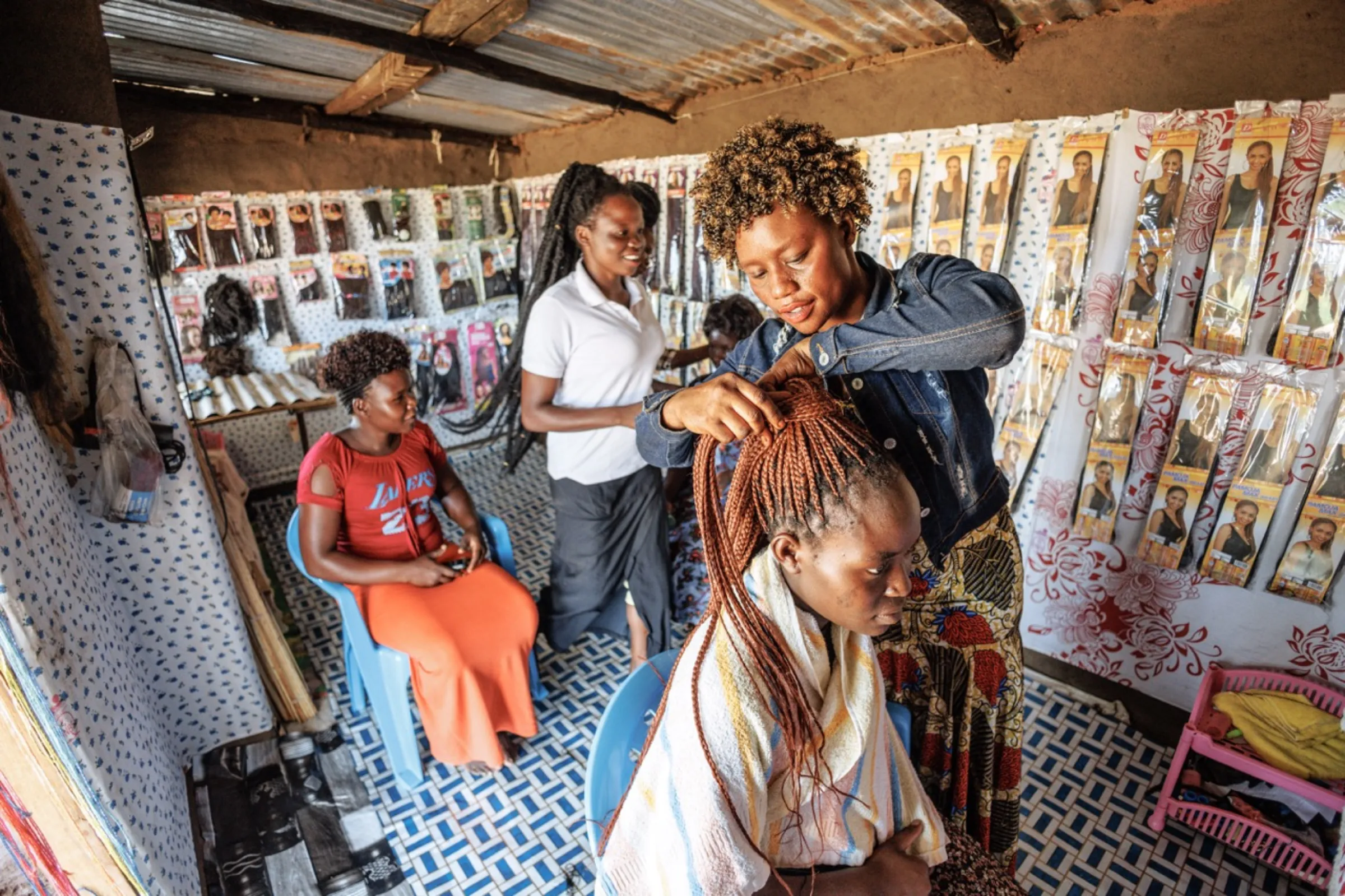It is clear that the aid systems that have supported refugees are under huge strain.
Refugees don't just need aid - they need help to rebuild lives
Opinion

Opinion
Viola works at her hair salon in Bidi Bidi camp in Uganda in 2024. Photo by Jjumba Martin for Village Enterprise/Handout via Thomson Reuters Foundation
Temporary fixes cannot deal with today’s refugee crises - we need to invest in long-term solutions and empower refugees to live.
Tjada D’Oyen McKenna, CEO of global aid agency Mercy Corps, and Dianne Calvi, president and CEO of Village Enterprise, a non-profit working in rural Africa to end extreme poverty.
Viola was just 16 when she fled civil war in South Sudan, carrying her one-year-old daughter to safety in northern Uganda. She and her family settled in Bidi Bidi, a vast refugee camp meant to offer temporary refuge. A decade later, Viola is still there.
Viola’s story is far from unique. She is one of nearly two million refugees in Uganda and one of 122 million forcibly displaced people globally, a decade-high number primarily due to the convergence of conflict and climate change. Yet even as millions of people are fleeing violence, drought and floods, it is clear that the aid systems that have supported refugees are under huge strain.
World Food Programme Uganda has announced that one million refugees will see cuts to food assistance. And with more countries slashing international aid to redirect funding toward domestic or defence priorities – a reported $60 billion in cuts from the U.S. and £6 billion from the UK by 2027 – the future of global humanitarian response appears even more uncertain.
When we can see that this immense and growing need will not be met by the current support system, it is clear that we must collectively take a new approach to supporting refugees. Because the hard truth, lived by Viola and millions of refugees living in camps – not for weeks or months, but for years and decades – is that displacement is no longer temporary. We’ve spent decades designing refugee assistance around short-term emergencies. But what happens when a crisis lasts 10, 15 or 25 years?
A fundamental shift is needed, from delivering short-term aid to investing in agency and long-term solutions. Studies show that every $1 invested in refugee inclusion yields approximately $2 in economic benefits within five years. In Uganda, the World Bank found that policies allowing refugees to work and access land have cut the annual cost of support per person from $343 to just $193, and with full economic integration, it could decrease costs to $39 per person, an 89% decrease. Investing in livelihoods doesn't just reduce long-term dependency; it delivers measurable returns for host countries and donors alike.
Our organisations, Mercy Corps and Village Enterprise, have been working together in Bidi Bidi on one such project that is helping refugees start small enterprises. The programme, called DREAMS, combines a proven poverty intervention called poverty graduation with the development of market ecosystems.
Refugees receive nine weeks of entrepreneurship training, covering business essentials such as financial literacy, bookkeeping and operations. They form groups of three and receive startup cash alongside mentoring by a local business mentor, also a South Sudanese refugee. Then together, they launch a business. To boost their chances of success, high-opportunity value chains are identified and private sector companies and distributors are brought on board to create stronger local markets for the small businesses to operate in.
Viola joined the DREAMS programme in 2022. Today she owns a successful hair salon in Bidi Bidi, employing four people from the community. Viola has used the revenue from her business to build a house for her family and to pay for her daughter and nieces and nephews to attend school.
She is among 22,800 refugees who have participated in the DREAMS programme which has led to the creation of 7,600 businesses in refugee settlements in Uganda and Ethiopia since launching in 2022. Three quarters of participants have reported an increase in their household income over the past year.
Viola’s story shows what is possible when refugees have the chance to build livelihoods. Today, she’s no longer waiting for aid or hoping to return home. She’s building her future.
In the face of shrinking aid budgets and escalating displacement, we are at a global inflection point. Temporary solutions no longer meet the scale or duration of today’s crises. Governments, donors and the private sector must stop treating protracted displacement like a passing emergency and start investing in it like the long-term development challenge it has become.
Now is the moment to recommit to bold, sustainable, and scalable solutions that unleash the potential of refugees as contributors to their communities and economies. When we shift from aid to agency, from short-term relief to long-term investment, we not only protect dignity but create the promise of a sustainable future.
Any views expressed in this opinion piece are those of the author and not of Context or the Thomson Reuters Foundation.
Tags
- Wealth inequality
- Poverty
- Education
- Migration
Go Deeper
Related
MORE ON Socioeconomic Inclusion
Latest on Context
- 1
- 2
- 3
- 4
- 5
- 6


















